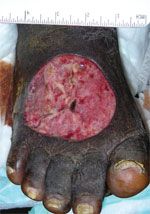Aeromonas hydrophila Cellulitis
This painful, purulent, malodorous, 5 x 5-cm ulcer developed a few days after the 71-year-old patient had struck his foot against a radiator. For the past 24 hours, he had subjective fevers and chills. He denied recent travel and saltwater or freshwater exposure. He had chronic lymphedema and admitted to drinking alcohol socially.
This painful, purulent, malodorous, 5 x 5-cm ulcer developed a few days after the 71-year-old patient had struck his foot against a radiator. For the past 24 hours, he had subjective fevers and chills. He denied recent travel and saltwater or freshwater exposure. He had chronic lymphedema and admitted to drinking alcohol socially.
Leukocytosis with bandemia was noted on hospital admission. Intravenous vancomycin was started; intravenous piperacillin/tazobactam was added the next day. A contrast CT scan of the right leg showed cellulitis without evidence of abscess or osteomyelitis. Blood cultures grew a gram-negative rod. Lower extremity venous Doppler studies revealed bilateral below-the-knee deep venous thromboses.
Low-grade fever and right foot swelling persisted despite therapy. Because of the lack of response, surgical debridement was performed. Deep tissue wound specimens grew Aeromonashydrophila that was sensitive to piperacillin/tazobactam. Vancomycin was discontinued; defervescence was noted following debridement, and the patient remained afebrile.

Further questioning revealed that the patient had recently cleaned and prepared fresh fish, which an acquaintance had brought from Virginia. His antibiotic regimen was changed to oral ciprofloxacin, and he was discharged.
It is important to take a thorough history and consider uncommon causes of cellulitis, especially when initial antibiotic therapy fails or risk factors for infection are present. This patient had several such risk factors, including prior lymphatic as well as venous insufficiency. He also had multiple hypodense hepatic lesions on CT scan and was a presumed “social” drinker of alcohol. Although these may have been incidental findings, liver disease may have increased his risk of further complications.
Aeromonas is an aerobic gram-negative rod usually found in freshwater and marine environments; it is most prominent in the Northern Hemisphere during the warmer months. The skin of the lower extremities is the most common site of infection, usually after traumatic exposure to contaminated water or soil. Aeromonas infection and cellulitis often develop within 8 to 48 hours of exposure, and systemic signs are common. Manifestations may include hemorrhagic bullae, subcutaneous bleeding, and purpura. Aeromonas is typically highly susceptible to penicillins combined with β-lactamase inhibitors, second- and third-generation cephalosporins, aminoglycosides, and fluoroquinolones.
When patients do not respond to antibiotics for presumed common cellulitis, it may be prudent to obtain further imaging such as CT or MRI of the affected limb to rule out soft tissue collections, soft tissue emphysema, and necrotizing fasciitis. Surgical debridement may be indicated for deep soft tissue infection, necrosis, and purulent collections that are inadequately draining.
References:
FOR MORE INFORMATION:
- Altwegg M. Aeromonas and Plesiomonas. In: Murray PR, Baron EJ, Pfaller MA,et al, eds. Manual of Clinical Microbiology. Washington, DC: ASM Press; 1999:507-516.
- Ko WC, Lee HC, Chuang YC, et al. Clinical features and therapeutic implicationsof 104 episodes of monomicrobial Aeromonas bacteraemia. J Infect. 2000;40:267-273.
- Lai CC, Shiao CC, Lu GD, Ding LW. Aeromonas hydrophila and Aeromonassobria bacteremia: rare pathogens of infection in a burn patient. Burns. 2007;33:255-257.
- Larka UB, Ulett D, Garrison T, Rockett MS. Aeromonas hydrophila infectionsafter penetrating foot trauma. J Foot Ankle Surg. 2003;42:305-308.
- Steinberg JP, Del Rio C. Other Gram-negative and Gram-variable bacilli. In:Mandell GL, Bennett JE, Dolin R, eds. Principles and Practice of Infectious Diseases.Philadelphia: Churchill Livingstone; 2005:2753-2754.
- Tsai YH, Hsu RW, Huang TJ, et al. Necrotizing soft-tissue infections and sepsiscaused by Vibrio vulnificus compared with those caused by Aeromonas species.J Bone Joint Surg Am. 2007;89:631-636.